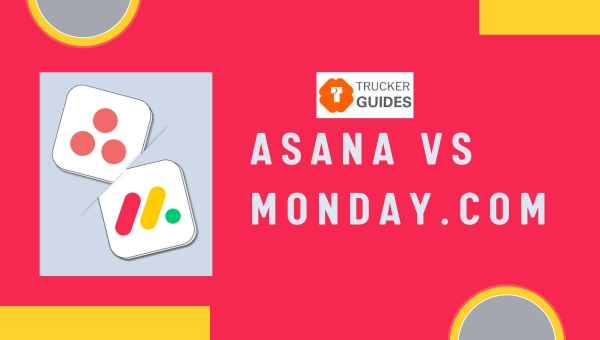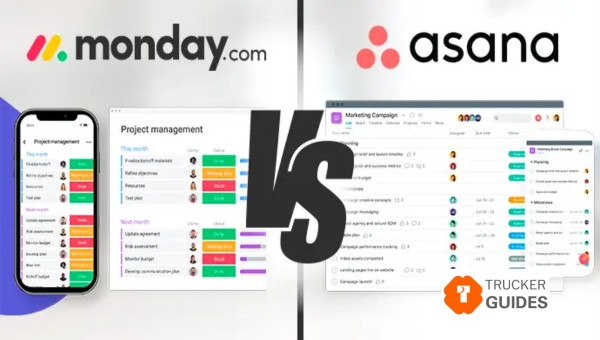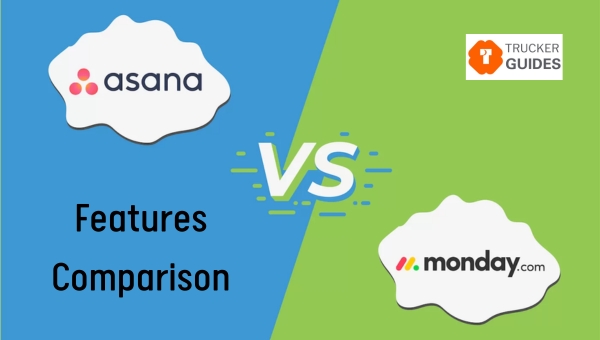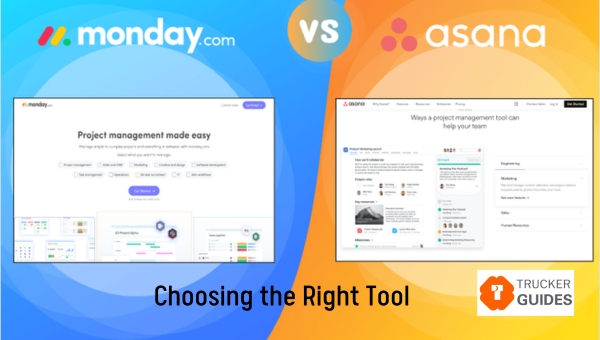Asana vs Monday.com [Compare Key Features Now]


The world of project management tools can be challenging, but you’ve come to the right place. In this article, we’ll delve into a comprehensive comparison of Asana vs Monday.com.
We’ll explore their features, pricing, pros and cons, and help you decide which tool is best for your needs. Whether you’re managing tasks, integrating platforms, or visualizing data, we’ve got you covered.
Asana and Monday.com are two major players in the world of project management tools, each offering unique features to help teams stay organized and efficient.

Both tools cater to different preferences and organizational needs, making them valuable for teams looking to enhance productivity and collaboration.
Founded in 2008 by Dustin Moskovitz and Justin Rosenstein, Asana is designed to streamline team collaboration and project management. Its primary function is to help teams track their work, align it with company goals, and automate workflows.
This makes it easier to manage tasks, monitor progress, and eliminate repetitive processes. Asana also offers features like goal alignment, workflow automation, and real-time progress monitoring. It even includes creative production enhancement and event management tools, making it versatile for various project types.
Asana is particularly popular among businesses aiming to enhance productivity and minimize distractions. With over 100,000 paying organizations and millions of users worldwide, it is a testament to its efficiency and reliability.
On the other hand, Monday.com was founded in 2012 by Roy Mann and Eran Zinman. Originally named daPulse, it quickly evolved to meet the needs of rapidly scaling organizations. By 2020, Monday.com had transformed into a Work Operating System (Work OS), allowing users to build custom applications.
Monday.com is known for its user-friendly interface and robust customization options. It supports a wide range of project management needs, from simple task tracking to complex workflow automation.
The platform also offers features like Monday workdocs and Monday apps, which enhance its functionality. Recognized as a leader in its field, Monday.com has received accolades for its innovative approach and has been listed as a top workplace globally.
Also Read: Postage Meters [The Ultimate Guide for Efficient Mailing]
When it comes to choosing between Asana and Monday.com, understanding their features is crucial.

Let’s dive into the key aspects that set these two project management tools apart, focusing on task management, integrations, workflow management, portfolio management, and data visualization.
Task management is at the heart of both Asana and Monday.com. Here’s how they stack up:
Integrations can significantly enhance the functionality of a project management tool. Here’s how Asana and Monday.com compare:
Efficient workflow management is essential for project success. Let’s see how both platforms perform:
Managing multiple projects effectively requires robust portfolio management features. Here’s a look at how Asana and Monday.com handle this:
Data visualization plays a vital role in decision-making. Let’s compare how Asana and Monday.com support this:
Both Asana and Monday.com offer robust features, each with its strengths. Understanding these differences can help you choose the best tool for your specific needs.
Also Read: Top 8 Best HR Outsourcing Companies to Watch
When deciding between Asana and Monday.com for your team or personal use, the pricing plans can be a crucial factor. Let’s take a closer look at the offerings from both platforms.
| Plan | Price per Seat | Total Monthly Price | Features |
|---|---|---|---|
| Free | €0 | €0 | – Up to 2 seats – 3 boards – Unlimited docs – 200+ templates – 8 column types – iOS and Android apps |
| Basic | €9 | €27 | – Unlimited free viewers – Unlimited items – 5GB file storage – Prioritized customer support – Dashboard based on 1 board |
| Standard | €12 | €36 | – Timeline & Gantt views – Calendar view – Guest access – 250 automation/month – 250 integrations/month – Dashboard combining 5 boards |
| Pro | €19 | €57 | – Private boards – Chart view – Time tracking – Formula column – 25K automation/month – 25K integrations/month – Dashboard combining 10 boards |
| Enterprise | Custom | Custom | – Enterprise-scale automation & integrations – Multi-level permissions – Enterprise-grade security & governance – Advanced reporting & analytics – Tailored onboarding – Enterprise support – Dashboard combining 50 boards |
| Plan Type | Price (per user, per month) | Features | User Limit |
|---|---|---|---|
| Free | Free forever | Collaborate with up to 10 teammates, unlimited tasks, projects, messages, activity log, file storage (100MB/file), basic search filters, mobile apps, 100+ free integrations | Up to 10 users |
| Starter | $13.49 billed monthly | Collaborate with up to 500 teammates, timeline view, Gantt view, Asana AI, workflow builder, project dashboards, advanced search, forms, 250 automation/month | Up to 500 users |
| Advanced | $30.49 billed monthly | Collaborate with up to 500 teammates, goals, 100 portfolios, workload, 25,000 automation/month, advanced reporting, and time tracking | Up to 500 users |
| Enterprise | Contact sales for pricing | No user seat limits, unlimited essentials, advanced integrations, custom branding, premium support, compliance features | N/A |
Choosing between Asana and Monday.com depends on your specific needs and budget. Both platforms offer robust features to help you manage and optimize your workflows effectively.
When choosing between Asana and Monday.com, it’s essential to weigh the pros and cons of each platform. Let’s dive into what each tool brings to the table, as well as their potential downsides.
| Pros | Cons |
|---|---|
| User-Friendly Interface | Limited Customization |
| Asana’s intuitive design allows teams to navigate and manage tasks easily without a steep learning curve. | Some users find the customization options somewhat limited compared to other platforms. |
| Task Management Features | Complexity for Large Projects |
| It excels in breaking down tasks into manageable pieces, allowing organization through lists, boards, and timelines. | While effective for small to medium-sized projects, managing very large projects can become cumbersome. |
| Integration Capabilities | Dependency Management |
| Asana supports numerous integrations with other tools, ensuring seamless collaboration across different platforms. | Users have noted that handling task dependencies can be tricky and less intuitive. |
| Workflow Automation | |
| The platform offers robust tools for automating workflows, streamlining processes, and improving efficiency. |
| Pros | Cons |
|---|---|
| Highly Customizable | Steeper Learning Curve |
| Monday.com offers extensive customization options, allowing teams to tailor their workspaces to fit specific needs. | The wide range of features and customization options can be overwhelming for new users. |
| Visual Workflow Management | Pricing |
| With its visually appealing interface, users can easily map out and monitor their workflows. | Some users feel that Monday.com can be more expensive compared to other project management tools. |
| Strong Integrations | Overwhelming Features |
| The platform supports a wide range of integrations, making it versatile for various business needs. | The plethora of features might be overkill for smaller teams or simpler projects. |
| Data Visualization Tools | |
| Monday.com provides robust data visualization options, helping teams make sense of their data through charts and dashboards. |
By understanding these pros and cons, you can make a more informed choice between Asana and Monday.com based on your team’s specific needs and preferences.
Also Read: Best 25 Ways to Collect Business Debt Fast and Easy
When it comes to selecting a project management tool that fits your team’s needs, Asana vs Monday.com are often the top contenders.

Both platforms offer robust features but cater to different scenarios. Let’s delve into identifying the specific use cases for each to help you navigate the decision-making process seamlessly.
Choosing between Asana and Monday.com depends largely on your team’s specific needs and the industry you operate. Here are some scenarios where each tool might be more suitable:
By understanding these use cases, you can better assess which tool aligns with your team’s operations and goals. Whether you need advanced task management, comprehensive workflow features, or intricate data visualization, there’s a solution tailored for you in Asana vs Monday.com.
Asana and Monday.com offer unique features that cater to different needs. Asana excels in task management and integrations, making it ideal for teams that require detailed project tracking.
On the other hand, Monday.com stands out with its user-friendly interface and robust workflow management, appealing to those who prioritize ease of use and efficiency.
Ultimately, the choice between Asana and Monday.com depends on your specific requirements and team preferences. By understanding the strengths and weaknesses of each tool, you can make an informed decision that best suits your project needs.